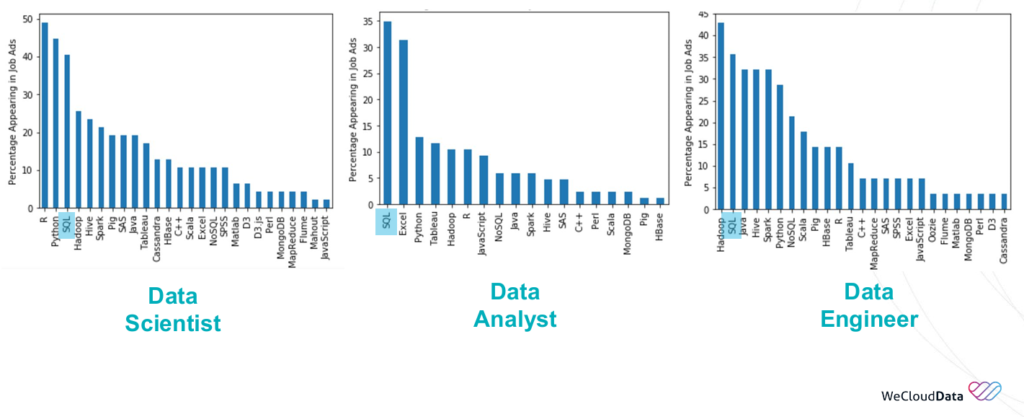Blog, Learning Guide
Welcome back! In our previous blog, “From Zero to 🤗: Your First Hug with Hugging Face,” we introduced the…
by WeCloudData
May 28, 2025
Blog
SQL(Structured query language ) is a domain-specific programming language for processing and storing information in a relational database. A relational database organizes data into tables and defines relationships between these tables to ensure efficient information retrieval. SQL is widely used in database administration, data analysis, and software development, making it an essential skill for tech industry professionals.
This blog is an introduction to Standard Query Language, highlighting its usage and importance. In this blog, we will learn about SQL’s fundamental concepts, types, and commands. Let’s get started with WeCloudData!
SQL is the abbreviation for Structured Query Language specifically designed for managing and querying relational databases. It was first developed in the 1970s by IBM researchers Donald D. Chamberlin and Raymond F. Boyce. SQL was originally known as the structured English query language (SEQUEL), the term was eventually shortened to SQL.
SQL is a popular query language that is frequently used in all types of applications. Key uses of Standard Query Language are listed below:

Standard Query Language is one of the most important tools for data management and analysis. SQL skills are in high demand in today’s job market. Its ability to handle complex datasets, perform complex queries, and integrate with other tools and programming languages makes it essential for businesses and professionals.
Standard Query Language is used across multiple domains:

SQL is categorized into five primary types based on its functionality. These command types form the foundation of SQL and enable users to perform a wide range of database operations.
Data Query Language (DQL): Used to query data from databases. The command to query data is SELECT.
Data Definition Language (DDL): Used to define and modify database structure. The command for DDL includes CREATE, ALTER, and DROP.
Data Manipulation Language (DML): Used to modify and manipulate data within tables. The commands for DML include INSERT, UPDATE, and DELETE.
Data Control Language (DCL): Manages permissions and access control to data. The command for DCL includes GRANT, and REVOKE.
Transaction Control Language (TCL): Used to ensure transaction integrity within the database. The command for TCL includes COMMIT and ROLLBACK.
The four most used and common commands of SQL are SELECT, INSERT, UPDATE, and DELETE. We will learn how to use these commands by following an example.

We have a table named ‘Product’ and want to fetch our desired data(ProductID and ProductName). For that, we will use the ‘SELECT’ command along with the name of the column we need. The query will give back data from only the two columns; ProductID and ProductName;
SELECT ProductID, ProductName FROM Product;
Next, we want to insert a new product into the ‘ProductName’ column in the ‘Product’ table, to do so we will use the ‘INSERT’ command. The command to insert a new entry to the table is given below;
INSERT INTO Product (ProductName) VALUES (‘NewProduct’);
We want to modify or update one of the product names (Epson FX-980 Dot Matrix Printer) to (Printer) from ‘ProductName’ to achieve the task we will use this SQL command.
UPDATE Product SET ProductName = ‘Printer’ WHERE ProductName = ‘Epson FX-980 Dot Matrix Printer’;
To delete a record from the table we use the ‘DELETE ‘ command. We want to delete a record from our table from the ‘Product_category’ column where the value is ‘technology’. The Standard Query Language query is listed below;
DELETE FROM Product WHERE Product_category = ‘Technology’;
Standard Query Language is an essential tool for managing and analyzing structured data. From database creation to data security, Standard Query Language remains a critical skill for IT professionals. Understanding SQL commands, database types, security threats, and certification opportunities will help individuals advance their careers in data management.
Looking to master SQL and enhance your data skills? WeCloudData offers industry-leading SQL courses designed for beginners and professionals alike. Whether you’re aiming for SQL certification, hands-on training, or advanced database management skills, WeCloudData provides expert-led instruction with real-world projects.
Take your career to the next level with WeCloudData’s SQL training in North America—your gateway to excelling in data analytics and database management!
Choosing WeCloudData means choosing a partner who is committed to your growth. With WeCloudData immersive training programs, comprehensive Python courses, and engaging video tutorials, you’re well-equipped to navigate the world of data and unlock endless opportunities. What WeCloudData offers;
Embrace the journey, enhance your skills, and transform your career with WeCloudData today!
"*" indicates required fields

WeCloudData is the leading data science and AI academy. Our blended learning courses have helped thousands of learners and many enterprises make successful leaps in their data journeys.
"*" indicates required fields
Canada:
180 Bloor St W #1003
Toronto, ON, Canada M5S 2V6
US:
16192 Coastal Hwy
Lewes, DE 19958, USA